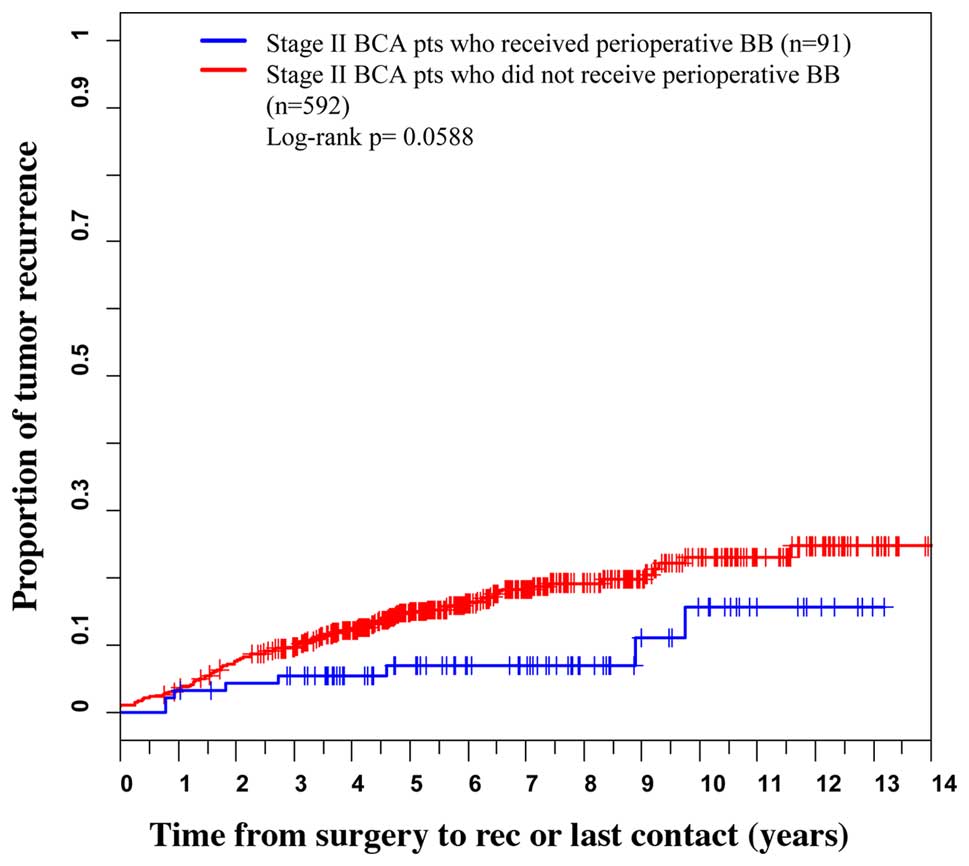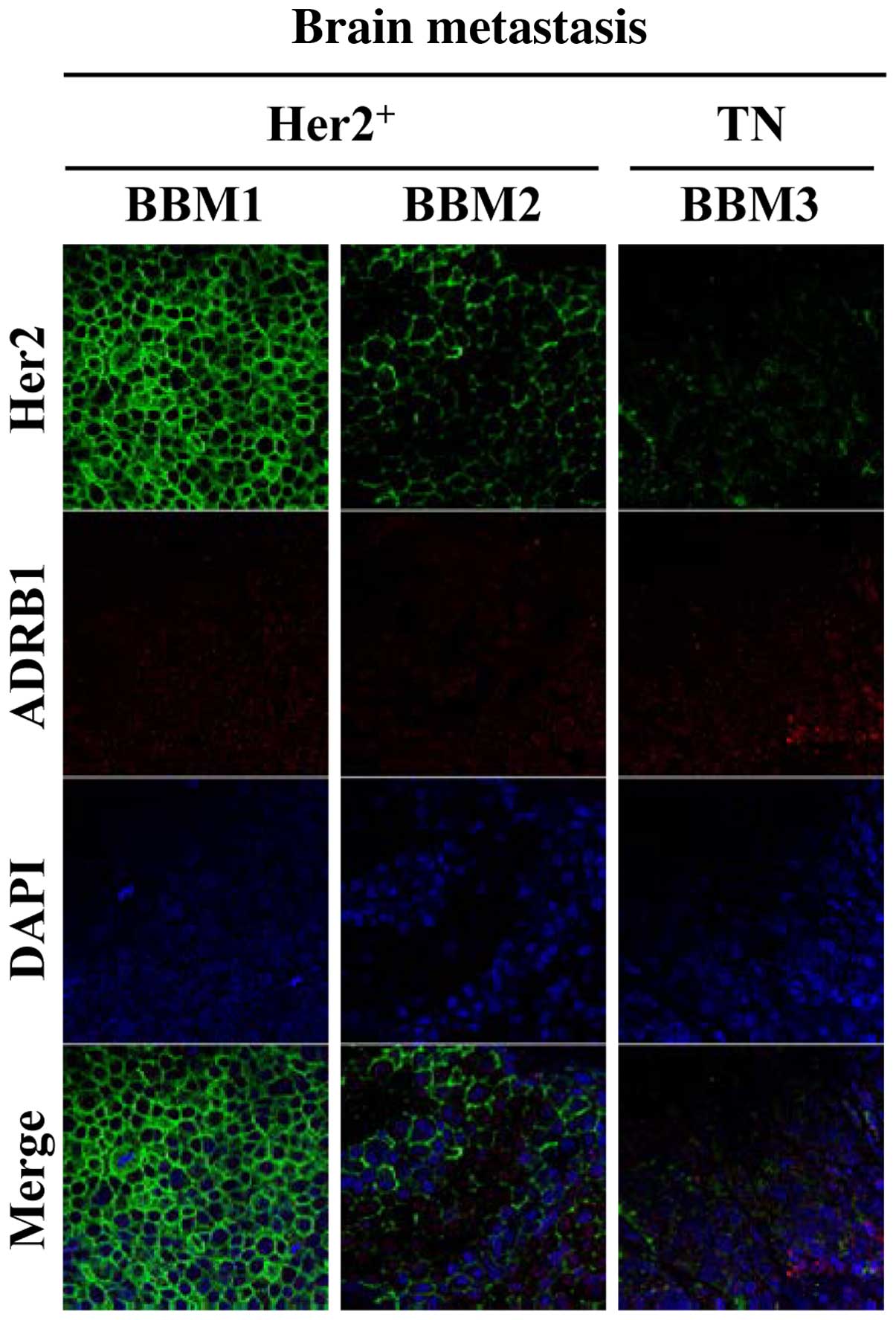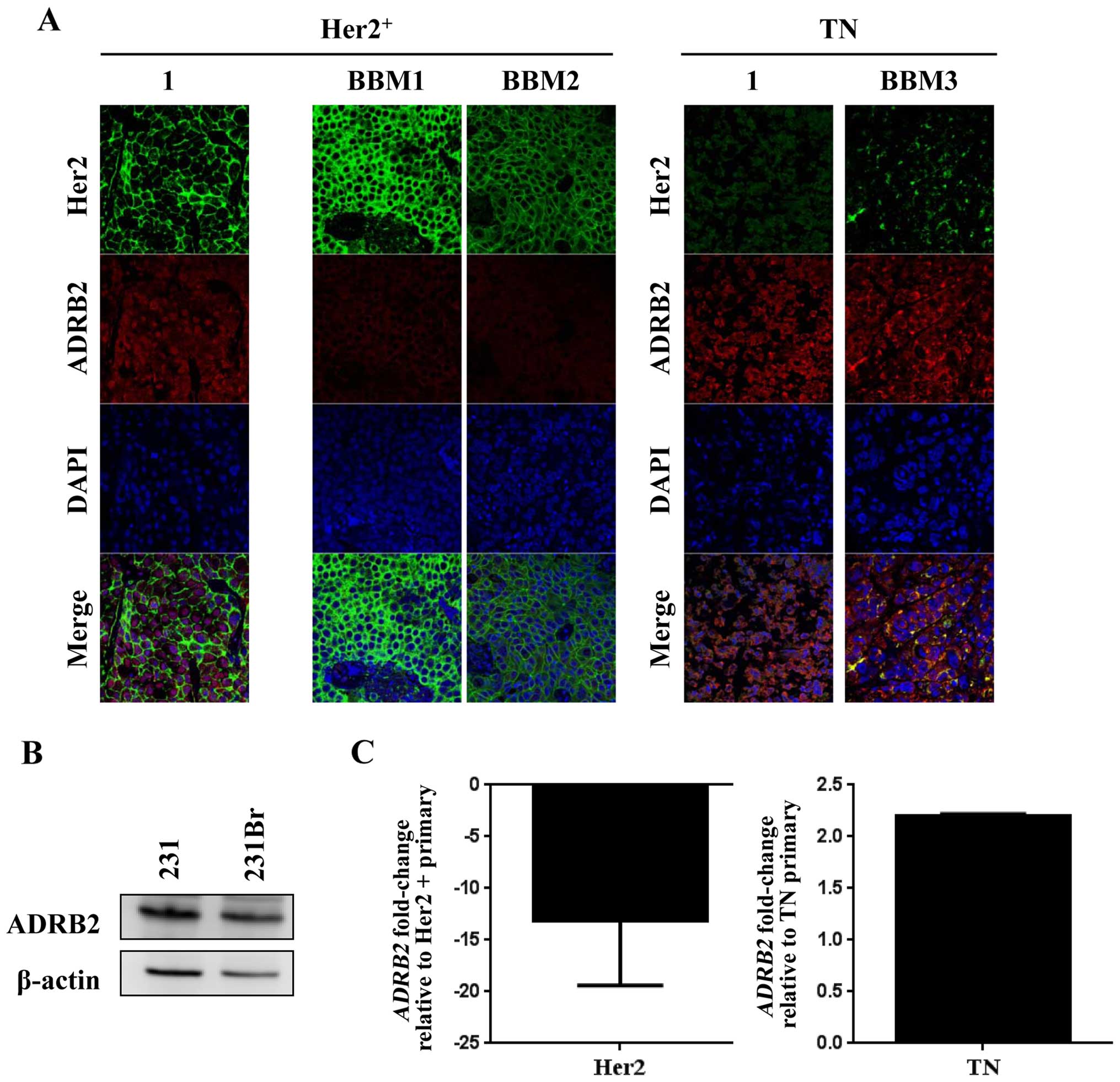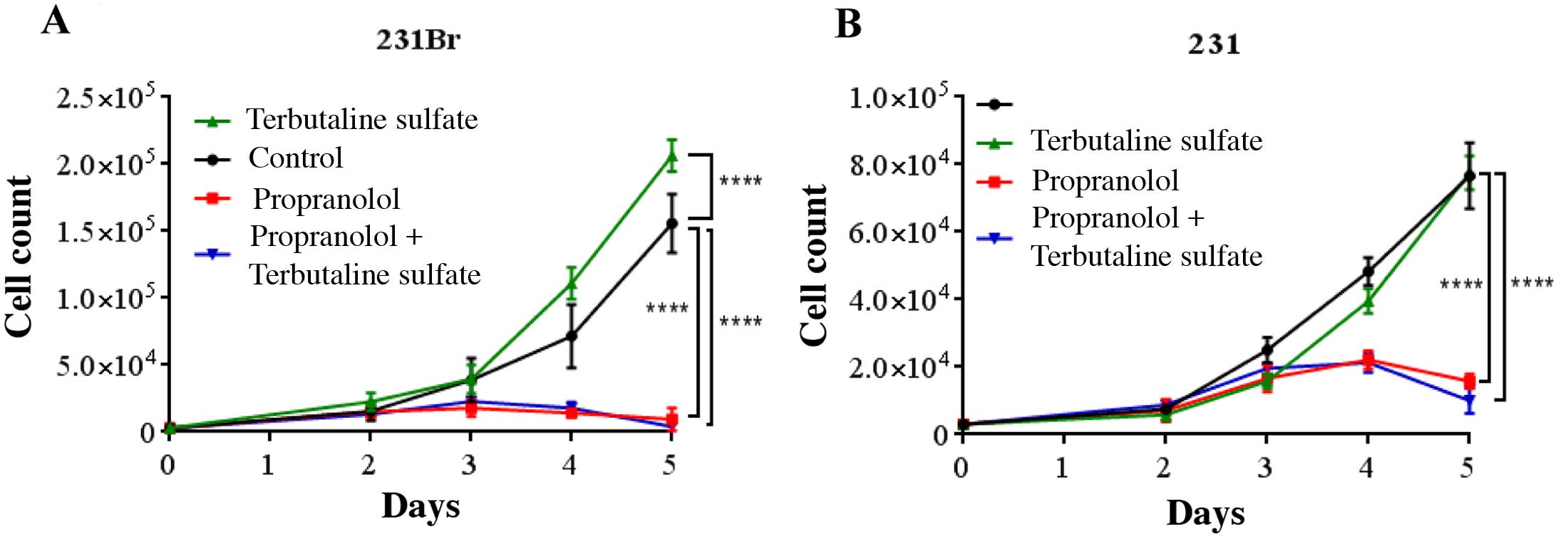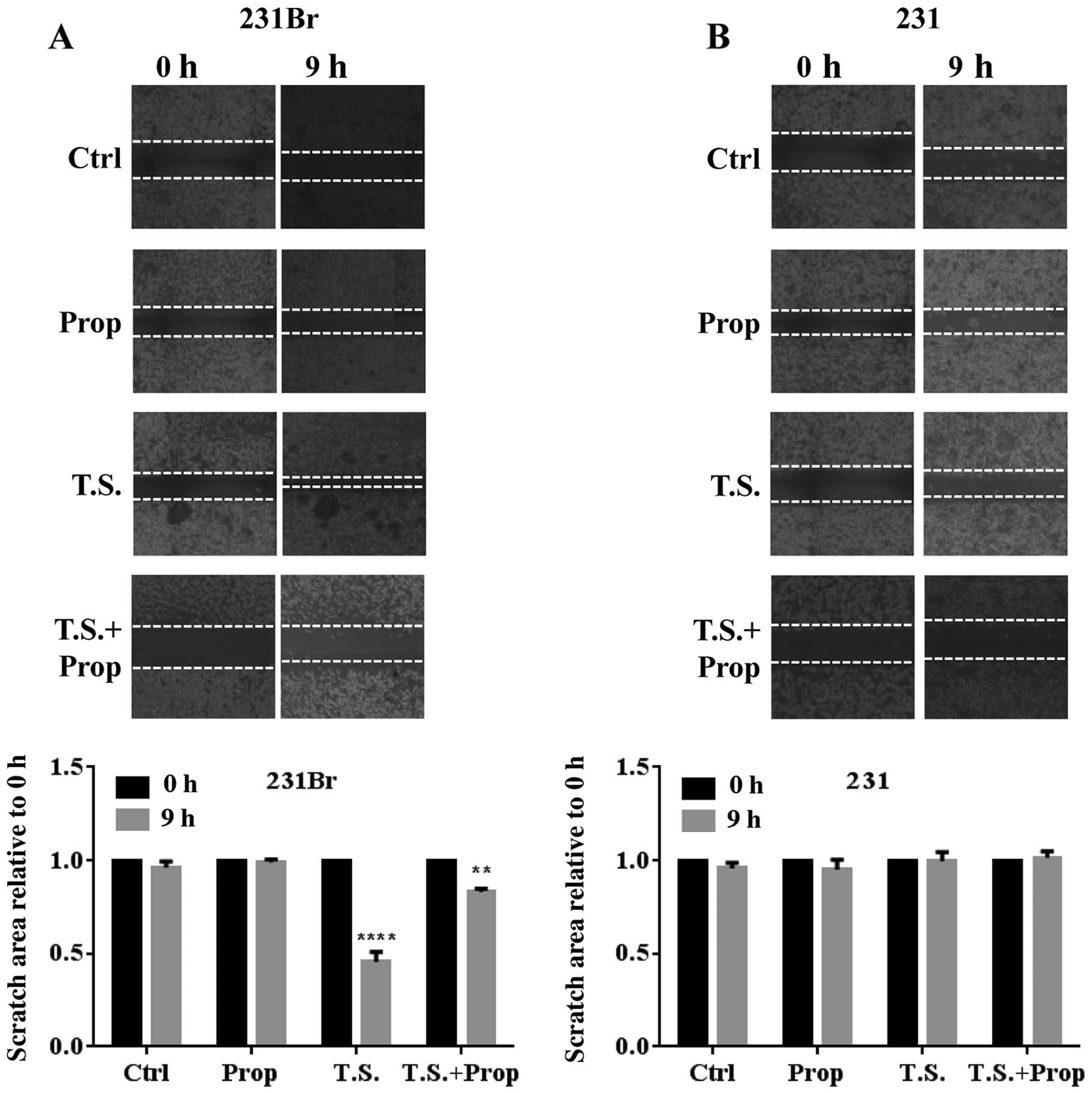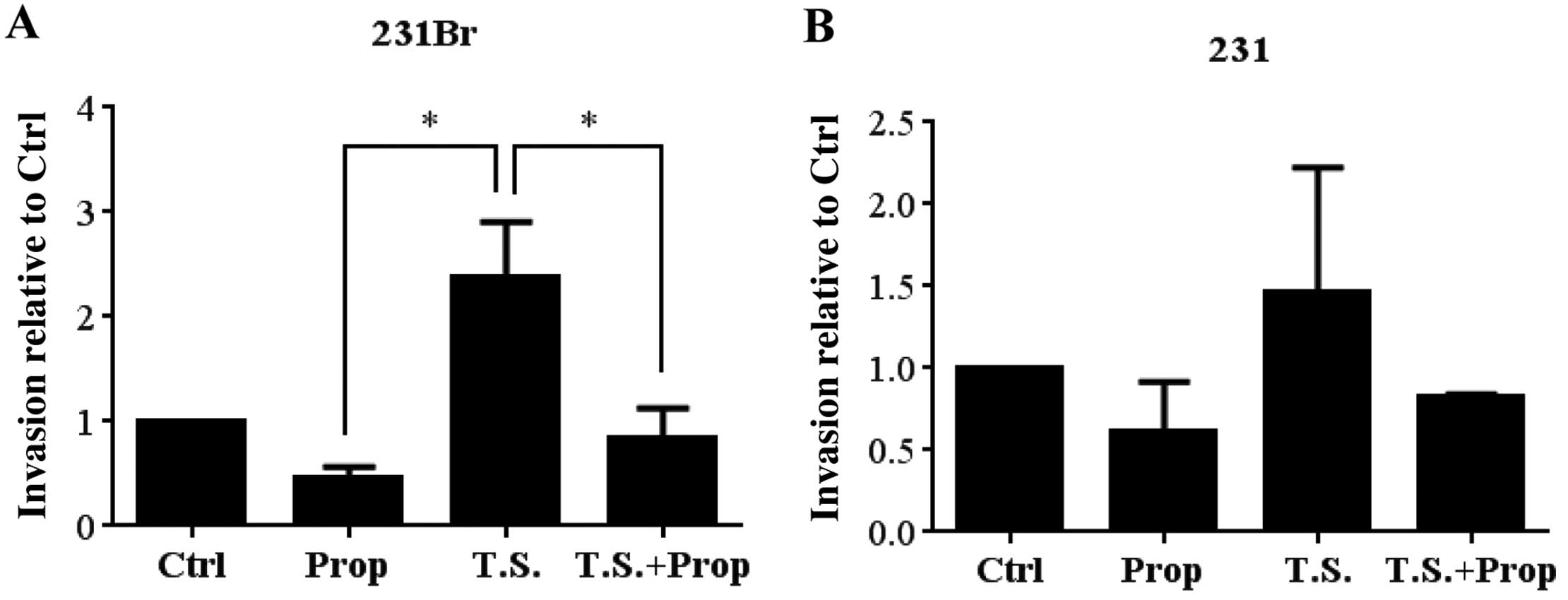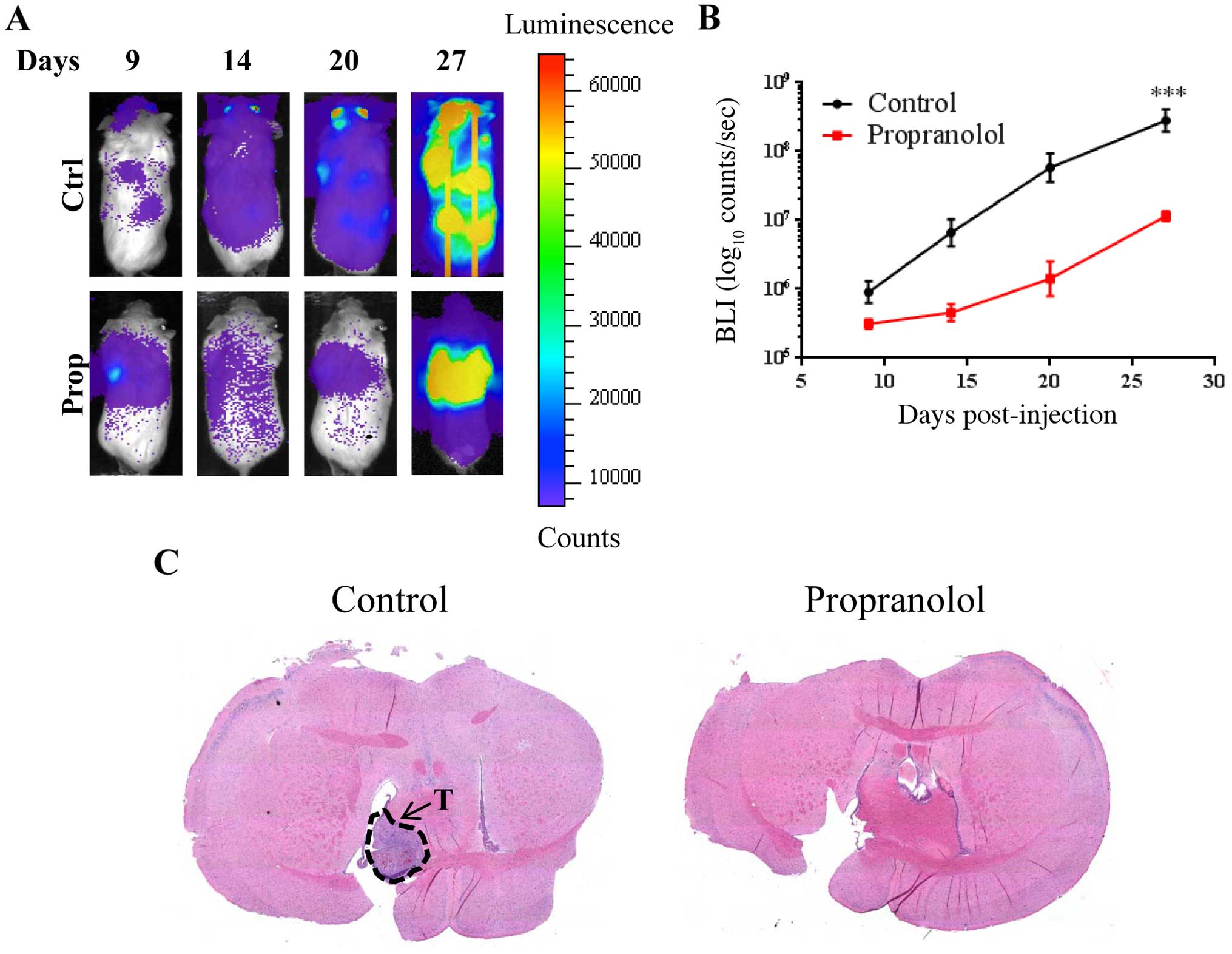Inhibition of β2-adrenergic receptor reduces triple-negative breast cancer brain metastases: The potential benefit of perioperative β-blockade
- Authors:
- Published online on: March 28, 2016 https://doi.org/10.3892/or.2016.4710
- Pages: 3135-3142
-
Copyright: © Choy et al. This is an open access article distributed under the terms of Creative Commons Attribution License.
Abstract
Introduction
Breast cancer is a common primary tumor type that can metastasize to the brain (1). Triple-negative (TN) breast cancer is especially aggressive, and approximately 6% of patients with TN breast cancer develop brain metastases (2,3). The prognosis of patients with TN brain metastases is a dismal 3 months.
Recent studies demonstrate a beneficial relationship between β-adrenergic receptor antagonists and breast cancer recurrence and metastases (4–6). Clinical data suggest that select β2-receptor antagonist intake by patients for cardiac indications was associated with higher recurrence-free and overall survival in the TN breast cancer subgroup (4,5). In select studies, no significant difference was observed in patients with estrogen receptor-positive (ER+) breast cancers or those who took β1-adrenergic receptor antagonist (4,5). Similarly, select β-receptor antagonists reduced formation of tumor recurrence and distant metastases in breast cancer patients (6).
Neurotransmitters have been implicated in the increasing metastatic potential of brain metastatic cells (7,8). Modern forms of Paget's 'seed and soil' hypothesis suggest that cells that carry or evolve adaptations to new microenvironments will successfully metastasize (9). One potential advantage for brain metastastic cells is the expression of functional neurotransmitter receptors, such as the β-adrenergic receptors. Epinephrine and norepinephrine bind to β-adrenergic receptors (10). As early as 1989, there was evidence suggesting a relevant role for β-adrenergic receptors in tumor progression, where administration of isoproterenol (β-adrenergic receptor agonist) to lung tumor cells increased cell proliferation, an effect abrogated by propranolol (β-adrenergic receptor antagonist) (11).
A standard treatment for patients with breast cancer is surgical tumor resection. Stress and the corresponding increased β-adrenergic receptor activation from surgeries increased the tumor growth and metastasis, in in vivo mouse experiments which were abrogated by propranolol (12,13). Stress signaling can be activated by norepinephrine. Norepinephrine administration to cancer cells can increase migration and invasion, two characteristics of metastasis, in addition to endothelium adhesion (14,15). It has been suggested that perioperative β-blockade may play a role in reducing cancer recurrence and metastases (16), which has been demonstrated in animal models (17). Propranolol inhibits norepinephrine-induced invasion and migration of cancer cells (18,19). The possible benefit of β-adrenergic blockade in human breast cancer patients during perioperative surgery-induced stress has not yet been investigated.
We performed a retrospective cohort study to test for an association between perioperative β-blocker use and postoperative breast cancer recurrence and metastases. Subsequently, we utilized the established MDA-MB-231 (231) primary TN breast cancer cells and its brain-trophic derivative, MDA-MB-231Br (231Br), in in vitro and in vivo studies to investigate the effects of β2-adrenergic receptor agonists and antagonists on the metastatic potential of TN breast cancer cells.
Materials and methods
Bioinformatic review and analysis
After IRB approval, female breast cancer patients diagnosed with stage II or III primary breast cancer who underwent mastectomy or segmentectomy at the City of Hope between the years 2000 and 2010 were identified through the City of Hope's Cancer Registry. A total of 1,029 subjects were included in the study. To determine the subjects taking perioperative β-blockers, a large-scale string-parsing query across electronic records of physician dictations and pharmacy data was conducted. Anesthesia records were neither computerized nor included in this study. All brand and generic names of β-blockers not specifically intended for glaucoma treatment and available in the United States were included in the study. Patients were considered to have been on perioperative β-blockers if the computational query of medical records, limited to 45 days from the patient's date of surgery, indicated β-blocker use. The time to recurrence was the primary endpoint during the data collection. Recurrence-free survival was measured from the date of surgery to the first recurrence (local or metastasis), death from oncological cause, or the date of the last follow-up, whichever occurred first. Kaplan-Meier estimates and Cox regression were performed to determine the effect that the perioperative administration of β-blockers had on cancer recurrence in our cohort.
Cell culture
The MDA-MB-231 (231) cell line, its brain-trophic derivative MDA-MB-231Br (231Br), a low passage TN brain metastasis cell line COH-BBM3 (BBM3), primary Her2+ breast cancer SkBr3 cell line, and low passage Her2-amplified brain metastasis cell lines COH-BBM1 (BBM1), COH-BBM2 (BBM2) were cultured in Dulbecco's modified Eagle's medium (DMEM)-F12 media (Life Technologies) supplemented with 10% fetal bovine serum (FBS; Hyclone), 1% glutamax and 1% antibiotic-antimycotic (both from Life Technologies) (7).
Immunohistochemistry of paraffin-embedded tissue
Patient breast-to-brain metastasis (BBM) tissue specimens were obtained with IRB approval, formalin-fixed, and embedded. Paraffin blocks were sectioned onto slides (10 µm) and baked for 3 h. Wax was removed from the patient BBM tissue specimens and primary breast cancer array slides (US Biomax) by xylene, and the tissue was hydrated with a gradient of ethanol washes and PBS wash. For antigen retrieval, slides were boiled in 10 mM sodium-citrate buffer [Tris sodium citrate (J.T. Baker), pH 6.0] for 1 h. Slides were permeabilized in 0.3% Tween-20 (Sigma-Aldrich) at 37°C for 45 min and blocked with 1% bovine serum albumin (BSA; Sigma-Aldrich), 10% normal goat serum (NGS; Invitrogen), and 0.3 M glycine (Fisher Scientific) at room temperature for 1 h. Primary antibodies in a primary carrier of 1.5% NGS and 1% BSA in PBS were applied overnight at 4°C. Fluorescent secondary antibodies (Jackson ImmunoResearch Laboratories) were applied the following day for 1 h at room temperature protected from light. Coverslips (Warner Instruments) were placed on slides mounted with Immunogold with DAPI (Life Technologies). Slides were imaged on a Carl Zeiss LSM confocal microscope. Antibodies used were the following: ADRB1 (Cell Signaling Technology) and ADRB2 (Thermo Scientific).
qRT-PCR
mRNA was extracted from 1.0×106 231, 231Br, BBM1, BBM2, BBM3 or SkBr3 cells using an mRNA extraction kit (Qiagen). qPCR was performed on a Neurotransmitters and Receptors qPCR Array plate (SaBiosciences). Data for ADRB2 in the metastasis cell lines were quantified relative to their primary breast cancer subtype counterparts after normalization to actin, i.e., BBM3 and 231Br were compared to 231, and BBM1 and BBM2 were compared to SkBr3.
Western blot analysis
Cells were trypsinized and then centrifuged at 1,500 rpm for 5 min. Collected cells were homogenized by lysis buffer [glycerol, 3 M KCl and 10% NP-40 (all from Sigma-Aldrich), 1 M Tris (Bio-Rad) and 1 M DTT (Sigma-Aldrich)] in the presence of phosphatase inhibitor, EDTA, and protease inhibitor (all from Thermo Scientific) for 15 min. The tubes were spun down at 12,000 rpm for 10 min and the protein in the supernatant was collected. Forty micrograms of protein boiled for 5 min with loading buffer [95% laemmli, and 5% β-mercaptoethanol (both from Bio-Rad)] were loaded onto Mini-PROTEAN TGX gels (Bio-Rad). The gel was run at 200 V and transferred onto a membrane at 100 V for 1 h. After confirming protein transfer on the membrane with Ponceau staining, the membrane was blocked for 1 h with blocking buffer (Thermo Scientific). Primary antibody diluted in blocking buffer was applied overnight at 4°C. The following day, horseradish peroxidase (HRP)-conjugated secondary antibody (Thermo Scientific) was applied for 1 h at room temperature. Membranes were exposed to SuperSignal West Pico Chemiluminescent Substrate (Thermo Scientific) for 5 min. Membranes were scanned by Li-COR c-DiGit membrane scanner (Li-COR). Antibodies used were as follows: ADRB1 (Cell Signaling Technology), ADRB2 (Thermo Scientific) and β-actin (Cell Signaling Technology).
Cell proliferation
231 or 231Br cells (3.0×103/well) were seeded on 24-well plates. After 24 h, they were treated with one of the following treatments (day 0): propranolol (33.3 µM), terbutaline sulfate (16.67 µM), or a combination of propranolol and terbutaline sulfate. Cells were counted daily for 5 days.
Migration assays
231 or 231Br cells (7.0×104/well) were plated into a migration assay plate (Ibidi). Twenty-four hours after plating, a silicon separator was removed, mimicking scratch conditions, and one of the following treatments was applied: propranolol (100 µM), terbutaline sulfate (50 µM), or a combination of propranolol and terbutaline sulfate. Tiled images (2×5) were captured at 0 and 9 h under bright field microscopy and phase contrast microscopy at a ×5 magnification. Quantification at 9 h of migration was carried out through ImageJ relative to time 0 under bright field microscopic images. Representative qualitative images of the quantified areas were displayed by phase contrast images.
Invasion assays
Matrigel (3 mg/ml) was coated onto 0.8-µm invasion inserts (Millipore), which were placed each in a well of a 24-well plate in a 37°C incubator and allowed to solidify for 1 h. Cells (1.5×105) were placed in the insert in serum-free media. Serum-free media with or without drugs were placed in the well in the following concentrations: propranolol (100 µM), terbutaline sulfate (50 µM), or a combination of propranolol and terbutaline sulfate. After 24 h, the inserts were washed in PBS, cells were fixed with 4% paraformaldehyde for 10 min at room temperature and stained with crystal violet (0.2% in 25% methanol) for 15 min at room temperature. Remaining cells and Matrigel were swabbed out with Q-tips. Five sections on each insert were imaged by bright-field at a ×5 magnification under a Zeiss Observer Z1 Live Cell microscope and quantified. Calculations were carried out relative to the invasion of the control cells.
In vivo animal models
231Br cells (5.0×104) labeled with firefly-luciferase remained untreated or were pre-treated with propranolol (33.3 µM) for 12 h. Cells were injected into NOD-SCID mice in the intracardial space under IACUC approval (City of Hope IACUC #10044). Tumors were monitored weekly by bioluminescence imaging (BLI). Upon euthanasia, the brains were dissected, fixed in formalin, and sectioned onto slides in 10-µm sections for hematoxylin and eosin staining to confirm tumor location. Images were acquired and tiled at ×5 magnification.
Results
Patients receiving perioperative β-blockers have a lower rate of postoperative cancer recurrence and metastases
The median age (range) of the patients at diagnosis was 53 years (21–92). Sixty-eight percent of our subjects were stage II patients and 91 of these subjects received perioperative β-blockers. We found that for stage II patients who received perioperative β-blockers the hazard ratio for recurrence and metastases calculated with the Cox regression was 0.51. (95% CI: 0.23–0.97; p=0.041). The log-rank test for this stage II subgroup did not achieve statistical significance at the α=0.05 level (p=0.0588). The Kaplan-Meier curves appear in Fig. 1. There was no statistical difference in post-operative recurrence associated with β-blocker usage for stage III breast cancer patients. In addition, there was no difference in overall survival with β-blocker use for either group.
Triple-negative primary breast cancer and brain metastatic tissues express ADRB2
We then investigated the effects of β-adrenergic receptor activation and blockade on both primary breast cancer and brain metastatic cells. Since β1- and β2-adrenergic receptor subtypes are frequently targeted by β-blockers, we initially analyzed expression of these subtypes in formalin-fixed patient brain metastatic specimens. ADRB1 expression was low in the Her2+ and TN brain metastatic tissues (Fig. 2). There was low β2-adrenergic receptor (ADRB2) expression in the Her2+ brain metastatic tumors compared to the primary Her2+ breast tumors and consistently high β2-adrenergic receptor expression in TN primary and brain metastatic tumors (Fig. 3A). For this reason, we decided to focus our experiments on the β2-adrenergic receptor in the TN tumor subtype. For the purposes of our study, we utilized the TN primary breast cancer cell line 231 and its brain-derivative 231Br. The high expression of β2-adrenergic receptor protein (ADRB2) in TN primary and metastatic cells was observed by western blot analyses (Fig. 3B). Finally, to confirm decreased ADRB2 in Her2 brain metastases and increased ADRB2 in TN brain metastases compared to their primary breast cancer subtypes, we analyzed ADRB2 expression at the mRNA level with qRT-PCR. We analyzed 2 separate Her2+ brain metastasis cell lines (COH-BBM1, and COH-BBM2) with an Her2+ primary breast cancer cell line (SkBr3) and 2 separate TN brain metastatic cell lines (COH-BBM3 and 231Br) with a TN primary breast cancer cell line (231). Her2+ brain metastatic cells expressed a 16-fold decrease in ADRB2 compared to primary Her2+ cells and TN brain metastatic cells with a 2-fold increase compared to primary TN cells (Fig. 3C).
β2-adrenergic receptor agonists promote proliferation of brain metastatic cells
We investigated the effects of β2-adrenergic receptor activation on characteristics of metastasis, namely proliferation, migration and invasion (20,21). Studies have shown that terbutaline sulfate, a β2-adrenergic receptor agonist, increases tumor weights similar to those under stress (22,23). Hence we used terbutaline sulfate to mimic stress conditions in vitro. Clinical data suggest a β1 to β2 ratio activity of propranolol to be 1:2, and its clinical effects may be duration-dependent (5). Propranolol also antagonized noradrenaline-induced β2-adrenergic receptor activation 2 to 3 times more than β1-adrenergic receptors (24), thus we utilized this commonly used antagonist to inhibit β2-adrenergic receptors.
We performed a proliferation assay over a 5-day period. Terbutaline sulfate significantly increased proliferation in brain metastatic cells (p<0.0001). Propranolol decreased the rate of cell proliferation compared to the control cells and also eliminated the effects of terbutaline sulfate when co-administered to cells in vitro (p<0.0001) (Fig. 4A). 231 cells were not sensitive to terbutaline sulfate. They were, however, sensitive to propranolol and displayed decreased cell proliferation when compared to the control cells (p<0.0001), including when combined with terbutaline sulfate (Fig. 4B).
β2-adrenergic receptor agonists promote migration of brain metastatic cells
We proceeded to observe another characteristic of metastasis, migration. After creating a scratch in the plate, we imaged the scratch after 9 h. At the concentrations utilized for this migration assay, we observed significant migration (p<0.0001) in 231Br cells treated with terbutaline sulfate. Approximately 50% of the scratch was filled after 9 h with terbutaline sulfate, and propranolol lessened these effects to ~80% compared to the control migration (p<0.01) (Fig. 5A). At 9 h, there was no significant difference in migration between the control and the propranolol-treated 231Br cells, as expected from data in a previous study (25). In 231 cells, no drug treatments at the utilized concentration made any significant difference in the migration into the scratch (Fig. 5B).
Propranolol decreases β2 agonist-promoted invasion in brain metastatic cells
The effects of the β2-adrenergic receptor agonists and antagonists on the third characteristic of metastasis, invasion, was analyzed through an invasion assay. Cells were placed on an invasion insert coated with Matrigel and allowed to invade for 24 h. There was a significant difference (p<0.05) in invasion between 231Br cells treated with propranolol and 231Br cells treated with terbutaline sulfate (Fig. 6A). There was also a significant decrease in 231Br cell invasion following treatment with propranolol + terbutaline sulfate (p<0.05) compared to cells treated with terbutaline sulfate. In the primary 231 breast cancer cells, there was no significant difference in cells treated with propranolol and/or terbutaline sulfate compared to the control cells at the concentrations used for 24 h (Fig. 6B).
Effects of propranolol on brain metastasis development in vivo
Finally, we investigated the effects of propranolol in vivo. 231Br cells labeled with firefly luciferase (231Br-FF) with or without a 12-h non-cytotoxic pre-treatment of propranolol were injected into female NOD/SCID mice and monitored for brain metastases by bioluminescence imaging (BLI). 231Br cells pretreated with propranolol established brain metastasis at significantly decreased rates (p<0.001) compared to the control cells (Fig. 7A and B). By day 27, the BLI showed increased brain metastases in the control cells when compared with the cells pre-treated with propranolol. In fact, the cells pre-treated with propranolol had higher qualitative BLI intensity in the lung, indicating increased lung metastasis. Tumor formation in the brain for mice injected with control 231Br-FF cells was confirmed by staining with hematoxylin and eosin (H&E) (Fig. 7C, left). Lack of tumor formation in the brain for mice injected with 231Br-FF cells pre-treated with propranolol was also confirmed by H&E staining (Fig. 7C, right).
Discussion
We found that stage II breast cancer patients who were administered β-blockers at the time of their tumor resection surgery had decreased postoperative cancer recurrence and metastases using Cox regression, and we suspect that statistical significance with the Kaplan-Meier estimate was limited by sample size. We found no difference in overall survival associated with perioperative β-blocker use. It should be noted that the patients were considered to be on perioperative β-blockers if computer-based review of electronic medical records indicated β-blocker use within 45 days of surgery. The review did not include anesthesia records. Overall, our results showed a potential beneficial association between β-blocker use and breast cancer recurrence and metastases in accordance with previous studies (4–6). Based on these findings, we explored cellular and biological mechanisms.
We investigated the effects of β2-adrenergic receptor agonists and antagonists on TN primary breast cancer and breast cancer brain metastatic cells. Regulation of metastasis development may stem from the body's own signaling substances, for example, the physiological levels of norepinephrine (26). Our previous research indicates that there is a bi-directional interaction between tumor cells and the physiological brain microenvironment. We continued our investigation into the effects of β2-adrenergic receptor targeting on three characteristics of metastasis: proliferation, migration and invasion. The data generated in this study further support the hypothesis that the brain microenvironment has the potential to aid the establishment of brain metastases.
Our initial studies showed high protein expression of the β2-adrenergic receptor in both TN primary and brain metastasis cells. Upon further investigation, at the concentrations of β2-adrenergic receptor agonists and antagonists utilized, brain metastatic cells responded to propranolol (β1 and β2-adrenergic receptor antagonist) by decreasing metastatic potential and to terbutaline sulfate (β2-adrenergic receptor agonist) by increasing metastatic potential. The primary breast cancer cells failed to show any response. External stress, such as surgery can stimulate epinephrine and norepinephrine release, which can increase metastatic ability (22). To mimic the response noted in surgical stress in vitro, we used terbutaline sulfate to activate the β2-adrenergic receptor (22,27). Treatment with terbutaline sulfate significantly increased cell proliferation and migration compared to the control brain metastatic cells. Terbutaline sulfate significantly increased cell invasion in the brain metastatic cells compared to the cells treated with propranolol. Combination treatment with propranolol and terbutaline sulfate abrogated the increased effects of terbutaline in regards to all three characteristics of metastasis in the brain metastatic cells, but not its primary breast cancer counterpart. In vivo, there was a significant decrease in brain metastasis in mice injected with cells pretreated with propranolol at a non-cytotoxic concentration and time of treatment.
There are discrepancies regarding the effects of β2-adrenergic receptor agonism or antagonism on cancer cells. Although other studies, including this study, have shown that β2-adrenergic receptor agonism increases metastatic potential (28–30), other studies indicate that β2-agonism increases apoptosis and tumor regression when using pirbuterol, a β2-adrenergic receptor agonist (31). This could be attributed to pathway specificity, whereas some agonists can block the Ras/Raf-1/Mek-1/Erk1/2 pathway (31), and some may inhibit the cAMP/PKA pathway (29).
Our results indicate that β2-adrenergic receptor treatment affects brain metastatic cells, or at the least brain metastatic cells have increased sensitivity to these treatments, potentially due to the adaptations metastatic cells have for the brain micro-environment. One reason for the differences in sensitivity of a primary breast cancer cell line and its brain metastatic cell line counterpart could be attributed to a pathway switch between the cells in a primary vs. a secondary microenvironment (13,22). Changes in the expression levels of β-adrenergic receptor subtypes were also noted in more aggressive derivatives of breast cancer cells, of which metastasis is one (32). Supporting our theory that brain metastatic cells have increased sensitivity to β2-adrenergic receptor targeting, propranolol alone in previous research inhibited norepinephrine-induced lymph node metastases in prostate cancer cells, but there were no effects on primary tumors (33). These could explain the decrease in the sensitivity of primary breast cancer cells to treatments targeting a neurotransmitter receptor.
We demonstrated a potential beneficial association between perioperative β-blockade and breast cancer recurrence and metastases. Such an association has been demonstrated for other cancer types in animal models (17). In addition, we showed that β2-adrenergic receptor activation of TN breast-to-brain metastatic cells increased in vitro proliferation, migration and invasion. These effects were blocked by propranolol. Propranolol also decreased establishment of brain metastases in vivo. Our findings add to a growing body of evidence that suggests a complex relationship between breast cancer metastases and β-adrenergic activation and inhibition. Further studies into this relationship and to the possible therapeutic applications of selective β2 antagonists are warranted. Eventually it may be possible to identify a subset of TN breast cancer patients who may benefit from therapeutic blockade of stress-induced catecholamine release during the perioperative period.
Abbreviations:
|
231Br |
MDA-MB-231Br |
|
ADRB2 |
β2-adrenergic receptor |
|
TN |
triple-negative |
|
BBM |
breast-to-brain metastasis |
|
231 |
MDA-MB-231 |
References
|
Schouten LJ, Rutten J, Huveneers HA and Twijnstra A: Incidence of brain metastases in a cohort of patients with carcinoma of the breast, colon, kidney, and lung and melanoma. Cancer. 94:2698–2705. 2002. View Article : Google Scholar : PubMed/NCBI | |
|
Pestalozzi BC: Brain metastases and subtypes of breast cancer. Ann Oncol. 20:803–805. 2009. View Article : Google Scholar : PubMed/NCBI | |
|
Tseng LM, Hsu NC, Chen SC, Lu YS, Lin CH, Chang DY, Li H, Lin YC, Chang HK, Chao TC, et al: Distant metastasis in triple-negative breast cancer. Neoplasma. 60:290–294. 2013. View Article : Google Scholar : PubMed/NCBI | |
|
Melhem-Bertrandt A, Chavez-Macgregor M, Lei X, Brown EN, Lee RT, Meric-Bernstam F, Sood AK, Conzen SD, Hortobagyi GN and Gonzalez-Angulo AM: Beta-blocker use is associated with improved relapse-free survival in patients with triple-negative breast cancer. J Clin Oncol. 29:2645–2652. 2011. View Article : Google Scholar : PubMed/NCBI | |
|
Barron TI, Connolly RM, Sharp L, Bennett K and Visvanathan K: Beta blockers and breast cancer mortality: A population-based study. J Clin Oncol. 29:2635–2644. 2011. View Article : Google Scholar : PubMed/NCBI | |
|
Powe DG, Voss MJ, Zänker KS, Habashy HO, Green AR, Ellis IO and Entschladen F: Beta-blocker drug therapy reduces secondary cancer formation in breast cancer and improves cancer specific survival. Oncotarget. 1:628–638. 2010. View Article : Google Scholar | |
|
Neman J, Termini J, Wilczynski S, Vaidehi N, Choy C, Kowolik CM, Li H, Hambrecht AC, Roberts E and Jandial R: Human breast cancer metastases to the brain display GABAergic properties in the neural niche. Proc Natl Acad Sci USA. 111:984–989. 2014. View Article : Google Scholar : PubMed/NCBI | |
|
Termini J, Neman J and Jandial R: Role of the neural niche in brain metastatic cancer. Cancer Res. 74:4011–4015. 2014. View Article : Google Scholar : PubMed/NCBI | |
|
Paget S: The distribution of secondary growths in cancer of the breast. 1889. Cancer Metastasis Rev. 8:98–101. 1989.PubMed/NCBI | |
|
Purves D, Augustine GJ, Fitzpatrick D, Katz LC, LaMantia AS, McNamara JO and Williams SM: Neuroscience. 2nd edition. Sinauer Associates; Sunderland, MA: 2001 | |
|
Schuller HM and Cole B: Regulation of cell proliferation by beta-adrenergic receptors in a human lung adenocarcinoma cell line. Carcinogenesis. 10:1753–1755. 1989. View Article : Google Scholar : PubMed/NCBI | |
|
Lee JW, Shahzad MM, Lin YG, Armaiz-Pena G, Mangala LS, Han HD, Kim HS, Nam EJ, Jennings NB, Halder J, et al: Surgical stress promotes tumor growth in ovarian carcinoma. Clin Cancer Res. 15:2695–2702. 2009. View Article : Google Scholar : PubMed/NCBI | |
|
Sloan EK, Priceman SJ, Cox BF, Yu S, Pimentel MA, Tangkanangnukul V, Arevalo JM, Morizono K, Karanikolas BD, Wu L, et al: The sympathetic nervous system induces a metastatic switch in primary breast cancer. Cancer Res. 70:7042–7052. 2010. View Article : Google Scholar : PubMed/NCBI | |
|
Huang XY, Wang HC, Yuan Z, Huang J and Zheng Q: Norepinephrine stimulates pancreatic cancer cell proliferation, migration and invasion via β-adrenergic receptor-dependent activation of P38/MAPK pathway. Hepatogastroenterology. 59:889–893. 2012. | |
|
Strell C, Niggemann B, Voss MJ, Powe DG, Zanker KS and Entschladen F: Norepinephrine promotes the β1-integrin-mediated adhesion of MDA-MB-231 cells to vascular endothelium by the induction of a GROα release. Mol Cancer Res. 10:197–207. 2012. View Article : Google Scholar | |
|
Gottschalk A, Sharma S, Ford J, Durieux ME and Tiouririne M: Review article: The role of the perioperative period in recurrence after cancer surgery. Anesth Analg. 110:1636–1643. 2010. View Article : Google Scholar : PubMed/NCBI | |
|
Benish M, Bartal I, Goldfarb Y, Levi B, Avraham R, Raz A and Ben-Eliyahu S: Perioperative use of beta-blockers and COX-2 inhibitors may improve immune competence and reduce the risk of tumor metastasis. Ann Surg Oncol. 15:2042–2052. 2008. View Article : Google Scholar : PubMed/NCBI | |
|
Sood AK, Bhatty R, Kamat AA, Landen CN, Han L, Thaker PH, Li Y, Gershenson DM, Lutgendorf S and Cole SW: Stress hormone-mediated invasion of ovarian cancer cells. Clin Cancer Res. 12:369–375. 2006. View Article : Google Scholar : PubMed/NCBI | |
|
Guo K, Ma Q, Wang L, Hu H, Li J, Zhang D and Zhang M: Norepinephrine-induced invasion by pancreatic cancer cells is inhibited by propranolol. Oncol Rep. 22:825–830. 2009.PubMed/NCBI | |
|
Marchesi F, Monti P, Leone BE, Zerbi A, Vecchi A, Piemonti L, Mantovani A and Allavena P: Increased survival, proliferation, and migration in metastatic human pancreatic tumor cells expressing functional CXCR4. Cancer Res. 64:8420–8427. 2004. View Article : Google Scholar : PubMed/NCBI | |
|
Entschladen F, Drell TL IV, Lang K, Joseph J and Zaenker KS: Tumour-cell migration, invasion, and metastasis: Navigation by neurotransmitters. Lancet Oncol. 5:254–258. 2004. View Article : Google Scholar : PubMed/NCBI | |
|
Tang J, Li Z, Lu L and Cho CH: β-adrenergic system, a backstage manipulator regulating tumour progression and drug target in cancer therapy. Semin Cancer Biol. 23:533–542. 2013. View Article : Google Scholar : PubMed/NCBI | |
|
Thaker PH, Han LY, Kamat AA, Arevalo JM, Takahashi R, Lu C, Jennings NB, Armaiz-Pena G, Bankson JA, Ravoori M, et al: Chronic stress promotes tumor growth and angiogenesis in a mouse model of ovarian carcinoma. Nat Med. 12:939–944. 2006. View Article : Google Scholar : PubMed/NCBI | |
|
Gille E, Lemoine H, Ehle B and Kaumann AJ: The affinity of (-)-propranolol for beta 1- and beta 2-adrenoceptors of human heart. Differential antagonism of the positive inotropic effects and adenylate cyclase stimulation by (-)-noradrenaline and (-)-adrenaline. Naunyn Schmiedebergs Arch Pharmacol. 331:60–70. 1985. View Article : Google Scholar : PubMed/NCBI | |
|
Masur K, Niggemann B, Zanker KS and Entschladen F: Norepinephrine-induced migration of SW 480 colon carcinoma cells is inhibited by beta-blockers. Cancer Res. 61:2866–2869. 2001.PubMed/NCBI | |
|
Drell TL IV, Joseph J, Lang K, Niggemann B, Zaenker KS and Entschladen F: Effects of neurotransmitters on the chemokinesis and chemotaxis of MDA-MB-468 human breast carcinoma cells. Breast Cancer Res Treat. 80:63–70. 2003. View Article : Google Scholar : PubMed/NCBI | |
|
Lucin KM, Sanders VM and Popovich PG: Stress hormones collaborate to induce lymphocyte apoptosis after high level spinal cord injury. J Neurochem. 110:1409–1421. 2009. View Article : Google Scholar : PubMed/NCBI | |
|
Pérez Piñero C, Bruzzone A, Sarappa MG, Castillo LF and Lüthy IA: Involvement of α2- and β2-adrenoceptors on breast cancer cell proliferation and tumour growth regulation. Br J Pharmacol. 166:721–736. 2012. View Article : Google Scholar | |
|
Zhang D, Ma QY, Hu HT and Zhang M: β2-adrenergic antagonists suppress pancreatic cancer cell invasion by inhibiting CREB, NFκB and AP-1. Cancer Biol Ther. 10:19–29. 2010. View Article : Google Scholar : PubMed/NCBI | |
|
Lang K and Bastian P: Neurotransmitter effects on tumor cells and leukocytes. Prog Exp Tumor Res. 39:99–121. 2007. View Article : Google Scholar : PubMed/NCBI | |
|
Carie AE and Sebti SM: A chemical biology approach identifies a beta-2 adrenergic receptor agonist that causes human tumor regression by blocking the Raf-1/Mek-1/Erk1/2 pathway. Oncogene. 26:3777–3788. 2007. View Article : Google Scholar : PubMed/NCBI | |
|
Badino GR, Novelli A, Girardi C and Di Carlo F: Evidence for functional beta-adrenoceptor subtypes in CG-5 breast cancer cell. Pharmacol Res. 33:255–260. 1996. View Article : Google Scholar : PubMed/NCBI | |
|
Palm D, Lang K, Niggemann B, Drell TL IV, Masur K, Zaenker KS and Entschladen F: The norepinephrine-driven metastasis development of PC-3 human prostate cancer cells in BALB/c nude mice is inhibited by beta-blockers. Int J Cancer. 118:2744–2749. 2006. View Article : Google Scholar |



